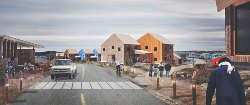New Ways of Looking at Housing in the North
August 1, 2016
The lack of healthy sustainable housing is one of the most pressing issues facing Inuit communities in the 21st century. Many communities suffer from a chronic lack of housing, and much of the housing that is available is in desperate need of repair. No matter the community in the Inuit Nunangat, a percentage of the population is affected by this problem.
Denise Piché, associate professor at University Laval in Quebec City, QC, has worked on housing initiatives around the world and now sets her sights on the housing crisis facing the North.
“The effects of housing, good or bad, have been well known since the 19th century for people all over the world. We know that bad housing creates health problems, and a lot of social tensions as well,” explains Piché. “We’ve had a lot of research on Inuit stating the exact same things, people cannot live in these bad conditions and be healthy, and we need to figure out the best way to address this problem.”
Piché is working with a team of other researchers from the University of Laval under the lead researcher Geneviève Vachon. The team has organized a pre-conference symposium, called Identity, Housing, Settlements and Landscapes: Designing a Way Forward in Nunangat. The symposium takes place on the eve of the 2016 Inuit Studies Conference and will feature 18 sessions throughout the day discussing different challenges facing Inuit housing strategies. The symposium will bring international thinkers and researchers from around the world to Memorial University in St. John’s to discuss ways forward in the northern housing crisis. Piché says she is excited to see the different solutions being used in other Nordic countries like Denmark and Norway.
“I’m a researcher, so the curiosity of comparative experiences across the Arctic space is very important,” says Piché, “we made an effort to bring in people from across the world, because we think it’s very important to see what the Sami, or the Inuit in Greenland, or what people in Alaska are doing.”
While there are many ways of addressing this important challenge, Piché believes that the bulk of Inuit housing solutions will be found in the realm of design. “We are bringing many different approaches from geographers to anthropologists and from architects and planners to the conference,” explains Piché “many topics that are being investigated now, and then we’ll have a look at how it’s been applied in housing design, in settlement design, and in landscape design.”
One of the major problems Piché has identified is that the designs for Inuit homes are developed by Kablunak (non-Inuit). The plans for these houses seem good on paper, but they do not always stand up to the harsh northern climate. More importantly Piché points out that the designs do not always reflect the needs of the Inuit. “We’ve been obsessed with solving the problems, of bringing water, of bringing energy, when the landscape is frozen most of the year,” says Piché with some frustration, “and these technical problems are very important, but we have to take into account the way people live and the way they want to live in the future.”
Piché says that the problems of housing in the North may be well known, but in order to find solutions that work in these environments, more Inuit need to be involved in the design process. “Unfortunately, it’s mainly researchers who are interpreting what they find out about the Inuit way of life,” Piché laments, “many of the researchers are people who have been living in the North for a long time, but we don’t have the direct participation of Inuit.”
While the symposium draws upon a variety of international researchers, Piché hopes that it will engage Inuit audiences who can add their voices to the discussion at the symposium. “We hope a lot of Inuit from Labrador, and other places, will be participating,” she explains, “we want to leave a lot of room for conversations so we hope that the participants in the conference will [join in the] conversation with researchers and designers as well.”
With this meeting of minds from around the world, Piché believes that this symposium will help advance the conversation on Inuit housing in the North. The pre-conference symposium, Identity, Housing, Settlements and Landscapes: Designing a Way Forward in Nunangat, takes place October 7, 2016, from 8:30 to 1730 in the Suncor Energy Hall at Memorial University’s School of Music.
Image: Kuujjuaq New housing with safe public space : Laurence Gaudette, Julien Landry, Brigitte Messier-Legendre and Laurence St-Jean





